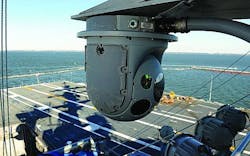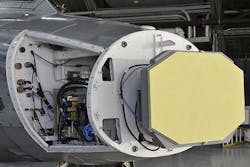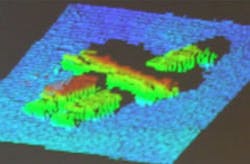Three U.S. companies take-on challenges of next-generation electro-optical and radio-frequency sensors
WRIGHT-PATTERSON AFB, Ohio – Three U.S. technology companies are helping U.S. Air Force researchers develop new enabling technologies for next-generation electro-optical (EO) and radio-frequency (RF) sensors, communications, information processing, imaging, and signals intelligence (SIGINT) applications.
Officials of the Air Force Research Laboratory at Wright-Patterson Air Force Base, Ohio, are working with Defense Engineering Corp. in Beavercreek, Ohio; optX Imaging Systems LLC in Lorton, Va.; and Lockheed Martin Space Systems in Louisville, Colo. on the Research and Development of Electro-Optical and Radio Frequency Sensors (RADERS) project.
Defense Engineering won a $3.9 million RADERS contract in August; optX Imaging Systems won a $748,315 RADERS contract in May; and Lockheed Martin won a $192,009 RADERS contract in August.
RADERS concerns 12 EO/RF technology areas:
-- antenna technologies and electromagnetic (EM) scattering;
-- electro-optic and infrared (EO/IR) sensor technology;
-- sensor information processing and integration;
-- EO/IR, spectral, and common-aperture electro-optic/radio-frequency (EO/RF) hardware and algorithms;
-- waveform phenomenology, design, and applications;
-- ultra-sensitive receivers for signals intelligence;
-- long-range day and night hyperspectral imaging research;
-- standoff high-resolution imaging;
-- infrared search and track (IRST) technology;
-- passive concept exploration;
-- laser radar (ladar) imaging, systems, components, and applications; and
-- RF sensor systems.
Defense Engineering will carry out EO/RF research in distributed radar electromagnetics and antennas for multispectral evaluation and research. Lockheed Martin, meanwhile, will carry out research in 3-D ladar targeting. The Air Force did not specify the research emphasis for optX Imaging.
Related: Air Force tells industry to prepare for upcoming RF and electro-optical research program
Of the 12 RADERS project topic areas, antenna technologies and electromagnetic scattering seeks to advance antenna and electromagnetic technology for air, ground and space-based applications, including radar, communications, satellite operations, and intelligence, surveillance and reconnaissance systems (ISR) from HF to W-band frequencies -- with an emphasis on detection, tracking, and data fusion for difficult targets.
EO/IR sensors technology centers on sensors and algorithms for target sensing, detection, recognition, and tracking with thermal imaging, single-aperture EO/RF sensing, hyperspectral imaging, multispectral sensing.
Sensor information processing and integration looks for new ways to process massive amounts of data coming from diverse sensor platforms for autonomous or semi-autonomous situation awareness, and actionable intelligence. This includes modeling and algorithms for distributed sensors, computational complexity, and identifying missing information.
EO/IR, spectral, and common-aperture electro-optic/radio-frequency (EO/RF) hardware and algorithms seeks to develop hardware and algorithms to detect low-signal targets in noisy and heavily cluttered environments using EO, IR, hyperspectral, multispectral, and common-aperture EO/RF sensors -- including focal-plane arrays (FPAs), hybrid FPAs, and infrared cameras for high-resolution low-power portable midwave and longwave infrared sensing.
Related: RF and electro-optical sensors with airborne drone and target detection introduced by FLIR
Waveform phenomenology looks at waveform agility, and the ability to identify signal phenomenology for new and difficult-to-detect RF waveforms. It will explore noise-like waveforms, interference-tolerant waveforms, and low-probability-of-intercept waveforms.
Ultra-sensitive receivers for signals intelligence concerns the relationship between a receiver noise floor and sensitivity to help detect, identify, and measure weak signals in the presence of strong signals.
Long-range day and night hyperspectral imaging research seeks to develop day and night hyperspectral component technologies to help detect and identify materials at extended ranges. This includes cryocoolers, FPAs, and spectrometers, as well as signal processing and algorithm development.
Standoff high-resolution imaging concerns long-range imaging at today's resolutions at double the range. This involves large-format high-temperature imaging and video arrays, reduced detector size, and high speed, low noise sampling.
Infrared search and track (IRST) technology seeks to develop an advanced long-range wide-field-of view staring infrared search and track system that operates at video rates for next-generation fire-control solutions at range along clear atmospheric paths and in cluttered air-to-air and air-to-ground environments.
Ladar imaging, systems, components, and applications seeks to apply ladar to intelligence, surveillance, and reconnaissance (ISR), precision attack and air-to-air engagements -- particularly to detect, track, and identify difficult air and ground targets in challenging environments.
RF sensor systems seeks to improve RF sensing systems for situational awareness and targeting, including monostatic radar, SIGINT), integrated air defense systems.
For more information contact Defense Engineering Corp. online at http://defengcorp.com, optX Imaging Systems at www.optximaging.com, Lockheed Martin Space Systems at www.lockheedmartin.com.
Ready to make a purchase? Search the Military & Aerospace Electronics Buyer's Guide for companies, new products, press releases, and videos



